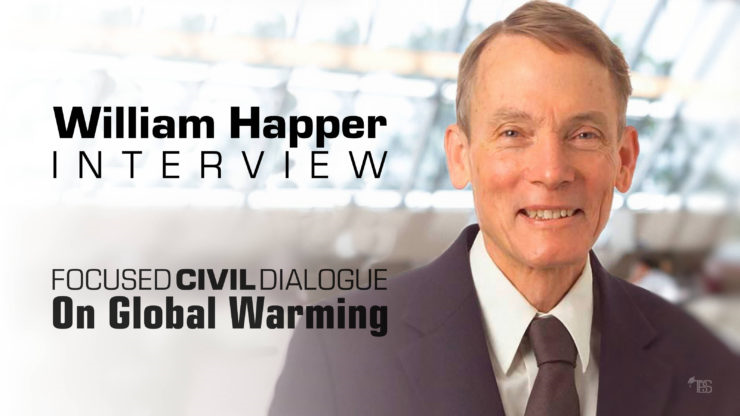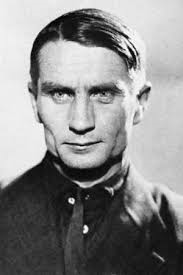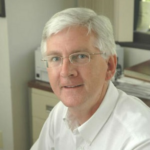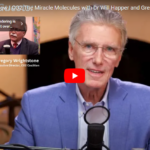
Het komt niet vaak voor dat een ‘posting’ op een website zo’n 17.000 woorden telt. Dat was wèl het geval met het interview met William Happer op de website ‘TheBestSchools’. Toch zou ik het van harte ter lezing willen aanbevelen voor klimatofielen van alle gezindten, want het geeft een goed inzicht in de opvattingen van de klimaatsceptici en komt heel dicht bij van wat men een ‘consensus’ onder hen zou kunnen noemen.
Happer is van huis uit natuurkundige die zich als klimaatscepticus ontpopte. Hij is thans als emeritus hoogleraar aan Princeton verbonden. Onlangs kwam hij op Climategate.nl langs als een van de geïnterviewden in de documentaire van Gideon Levy.
Het interview op ‘TheBestSchools’ was mede bedoeld als opstap naar een klimaatdialoog met de Australische wetenschapper David Karoly.
Voordat het interview in de klimaatmaterie duikt, vertelt Happer (1939) over zijn jeugd, zijn belevenissen direct na de oorlog en het begin van zijn wetenschappelijke loopbaan.
I was born on 27 July 1939, in Vellore, India. My father, also Dr. William Happer, was a Scottish medical officer in the Indian Army, and my mother, Dr. Gladys Morgan Happer, was a medical missionary for the Lutheran Church of North Carolina. On 1 September, a month after my birth, World War II began with the invasion of Poland by Nazi Germany and its ally, the Soviet Union.
En dan volgt een stukje persoonlijke en wereldgeschiedenis, waarvan hij als jong kind deel uitmaakte. Buitengewoon boeiend! Maar ik wil hier niet te veel over uitwijden.
In het begin van zijn wetenschappelijke carrière werkte hij op ‘Columbia University’ aan de verbetering van de prestaties van laser. Wat hij daar opstak, bleek later ook erg nuttig voor zijn studie van het klimaat. Daarna trad hij in dienst van het ministerie van energie, waar hij kennis maakte met de afwijkende wetenschappelijke mores die binnen de klimatologie heersten.
In 1990 I was appointed Director of the Office of Energy Research at the US Department of Energy (DOE) by President George H. W. Bush, where I served under Secretary of Energy, James Watkins, until the election of President Bill Clinton and Vice-President Al Gore in the 1992 election. …
The DOE Office of Science had an annual budget of over $3 billion at that time, more than the National Science Foundation. It funded almost all of DOE’s non-weapons basic research, including a great deal of environmental science and climate science. This was my first encounter with the climate establishment, and I was surprised to find environmental science so different from high-energy physics, nuclear physics, materials science, the human genome, and the many other areas we had responsibility for. I insisted that my assistant directors arrange for regular seminars, given by principal investigators of grants we supported. In most fields, principal investigators were delighted that government bureaucrats were actually interested in their research. They enjoyed being questioned during their talks, since this allowed them to show off their erudition. But, with honorable exceptions, principal investigators working on environmental issues were reluctant to come to our Washington offices, and evasive about answering the questions that were so welcome to briefers from other fields.
Zijn ervaringen met Al Gore waren al evenmin positief.
About three months after the beginning of the Clinton administration, Hazel O’Leary called me into her office to ask, “What have you done to Al Gore? I am told I have to fire you.” I assume that the main thing that upset Al Gore was my questioning of blatant propaganda about stratospheric ozone that was his focus at the time: “ozone holes over Kennebunkport” and similar nonsense. Although Secretary O’Leary offered to find a way to keep me at DOE as a civil servant, I was glad to have an excuse to get back to doing real science at Princeton University, which was kind enough to offer me a professorship again. ….
Vervolgens vertrok hij weer naar Princeton. In die periode begon hij zich mateloos te ergeren aan de onzin die hij voortdurend in de media hoorde en las over CO2 en klimaat. Hij besloot om zich daar publiekelijk tegen te keren.
 I often hear that since I am not a card-carrying climate scientist — that I, and many other scientists with views similar to mine, have no right to criticize the climate establishment. But as I have outlined above, few have a deeper understanding of the basic science of climate than I. … As we will see below, most climate models do not work. The history of science shows many examples of fields that needed outside criticism. A famous example is Andrei Sakharov’s leadership of opposition to Trofim Lysenko’s [zie foto] politicized biology in the Soviet Union. We will have more to say about Lysenko … later in the interview, but one of Lysenko’s main defenses was that Sakharov, a physicist who invented the Soviet hydrogen bomb, was not a “Michurinian” biologist. …
I often hear that since I am not a card-carrying climate scientist — that I, and many other scientists with views similar to mine, have no right to criticize the climate establishment. But as I have outlined above, few have a deeper understanding of the basic science of climate than I. … As we will see below, most climate models do not work. The history of science shows many examples of fields that needed outside criticism. A famous example is Andrei Sakharov’s leadership of opposition to Trofim Lysenko’s [zie foto] politicized biology in the Soviet Union. We will have more to say about Lysenko … later in the interview, but one of Lysenko’s main defenses was that Sakharov, a physicist who invented the Soviet hydrogen bomb, was not a “Michurinian” biologist. …
Kortom, soms blijkt dat slechts kritiek en druk van buitenaf tot een paradigmawisseling binnen een bepaalde wetenschappelijke discipline kan leiden, omdat op het betrokken wetenschappelijke terrein de druk van het groepsdenken dermate groot is, dat nieuwe inzichten worden geblokkeerd.
Vervolgens gaat Happer uitgebreid in op de lastercampagne van de Amerikaanse tak van Greenpeace, waarvan hij het slachtoffer was.
Greenpeace and other even more fanatical elements of the global-warming movement fully embrace the ancient lie that their ideological end — elimination of fossil fuel — justifies any means, including falsification of scientific data and character assassination of their opponents.
Maar Happer heeft zich daardoor niet uit het veld laten slaan.
Terzijde: Mij zijn geen soortgelijke praktijken van de Nederlandse tak van Greenpeace jegens klimaatsceptici alhier bekend. Dat siert hen!
Vervolgens richt het interview zich op de AGW-hypothese (AGW = ‘Anthropogenic Global Warming’).
Lees verder hier.
Daarover een volgende keer.
Voor mijn eerdere bijdragen over klimaat en aanverwante zaken zie hier, hier, hier, hier en hier.






Groots klimaat essay. Het laat ook duidelijk zien de overeenkomst tussen Al Gore en Stalin.
Warming is not the problem. Government action is the problem.
Geheel mee eens, die overheden deugen niet. Het wordt tijd dat rekenaars en experimentatoren gescheiden worden. Ze moeten onafhankelijk van elkaar, in onafhankelijke instituten, opereren, en zeker de experimentatoren mogen absoluut geen commentaar op hun eigen resultaten geven, alleen maar zo goed mogelijk meten.
De eenzijdigheid van de huidige klimaatwetenschap is van een tenenkrommend niveau. Vooral dat geleuter als ze weer een iets hogere temperatuur in een maand gemeten hebben. Slaat vaak nergens op, maar wordt bijv. door de NOS als groot nieuws gebracht.
Goh en wat doen de “sceptici” zich verschuilen in politieke “thinktanks” en opinie stukjes schrijven en vooral geen wetenschappelijk onderzoek
Maar dat vind Erik niet vreemd, hij vind ook al niet dat die mensen moeten stoppen met het verkondigen van hun opinie en de wetenschappers hun werk moeten laten doen, maar papegaaid ze gewoon na
De “sceptici” zijn die genen die de wetenschap politiseren
Uit het interview van William Happer las ik dat het zogenaamde tipping point bij Co2 toename er niet is. Een hele geruststelling voor mijn kleinkinderen.
Vijf honderd miljoen jaar geleden was het co2 gehalte 7000 ppm. Sindsdien heeft het leven op aarde zich ontwikkeld. Het klimaat ging zijn eigen gang, en het co2 gehalte DAALDE tot de huidige waarde. Wat heeft een stijging tot 400 of 800 ppm te betekenen?
En hoe warm was het toen het CO2 nivo zo hoog was? En hoe hoog stond toen de zeespiegel?
Maar André Bijkerk laat zich liever niet lijden door de geiten en gooit zijn klein kinderen liever onder de bus en weigert de consequenties te zien als hij er naast zou zitten
Groupthink dus !!
Er was toen een ijstijd, halverwege het Palezoicum, terwijl met een CO2-gehalte van 4500 ppm.
http://citeseerx.ist.psu.edu/viewdoc/download?doi=10.1.1.581.5318&rep=rep1&type=pdf
En dus dat wil nog niet zeggen dat CO2 geen effect is
Maar het wil wel zeggen dat een hogere CO2 concentratie geen probleem is.
Wat inderdaad moet gebeuren, is dat de het debat terug moet naar waar dit hoort, ergo de laboratoria, weerstations en onderzoeksinstituten. Dus het bedrijven van wetenschap zoals ook het zoeken naar bijvoorbeeld het Higgs-deeltje. Dit werd ook niet uitvoerig door een apart VN-panel (IPHIS; intergovernmental panel on Higgs influence on science of zoiets) besproken noch was het onderwerp van politiek. En dus zeker niet de parlementen, tv-debatten e.d. over bijvoorbeeld de snaartheorie in dit verband. https://www.nemokennislink.nl/publicaties/theorie-van-alles-of-niets
Een goede opmerking is deze: “Experimentele fysica is het laboratorium van de theoretische fysica. Theoretische fysica is niets waard tot het laboratorium heeft laten zien dat het klopt. Ik denk dat de hoeveelheid informatie die we over de natuur hebben gewoon niet groot genoeg is. Er ontbreekt iets.”
Zo zou het ook moeten gaan met het onderzoek naar de klimaatwisselingen. Dit in plaats van de hysterie die ons thans in haar greep heeft. Dit lijkt mij de kern van het betoog in dit artikel over Happer.
De plek waar Jeroen de wetenschap niet wil laten is in de laboratoria en de onderzoeksinstituten, hij politiseert liever door ellenlange niet onderbouwde onzin neer te pennen
Even op voorhand mijn excuses aan Rypke, Jeroen en Hans.
Henk, eigenlijk is het zonde van mijn tijd om nog op jou te reageren. Maar vertel mij de logica eens: Jeroen H. zegt dat het debat terug moet naar de wetenschap. Vervolgens krijg jij het voor elkaar om in een reactie daarop te stellen dat hij het tegenovergestelde beweert.
Ik vind dat heel erg knap van je. Petje af.
Nou jeroen,
Laat dan maar eens zien waar Jeroen zich als kampioen van de wetenschap laat zien door zijn mening te baseren op zo iets banaals als wetenschappelijk onderzoek en dat hij de uitkomsten daarvan accepteerd?
Verder is hij secretaris van een politiek lobby clubje
Feiten weizen er op dat Jeroen H zich niet laat leiden door wetenschap
Maar laat eens zien waar Jeroen zijn opinie laat beïnvloeden door wetenschappelijk onderzoek…..
Hij is secretaris van de groene teken kamer een lobby clubje
Ere wie ere toekomt: het was David die deze link een paar dagen geleden al postte.
Ik was het al aan het lezen, maar ben nauwelijks op de helft. Is nogal een hele rit.
Er zit wel een joekel van een (interpreteatie) fout in trouwens, maar die gaat over het biologische deel, niet over het klimaat deel.
Niet voor niks trek ik af en toe even de God-kaart, want klimaat kun je NIET los zien van (duurzaam) leven!
Als je dat doet dan krijg je idd totaal verkeerde interpretaties als ‘als het bliksemt dat God dan kwaad is’. Er is zelfs een dag naar genoemd: donderdag.
Het tegendeel is echter waar.
Anders gezegd: als je je UITSLUITEND met het klimaat bezig houdt, dan ontgaat je de helft. Daarom heeft het ook geen énkele zin met grafiekjes te strooien om de simpele reden: je mist dan de helft!
Klimaat is méér dan alleen maar het klimaat.
Een vulkaan uitbarsting is veel méér dan alleen maar een vulkaan uitbarsting.
Een mega tip om niet in die ‘donderdag-val’ te trappen:
Bekijk ALLE rampen eens van de goede kant. En dan in het kader van duurzaam leven.
Toegegeven: je ziet het pas als je het doorhebt.
Maar als je het doorhebt dan verandert dat je hele perceptie.
En voor de duizendste keer: CO2 grafiekjes mieren neuken leiden tot geen énkele (nieuwe) perceptie NOCH tot enig ander voortschrijdend inzicht.
Daarom zei ik eerder al: op de huidige manier kun je 100 jaar lang doorklooien met CG zonder iets te bereiken.
Bedenk ook het volgende: HOE zou het leven er uit zien, hoe zouden wij leven als er geen énkele (natuurlijke) bedreiging, vijanden of tekorten zouden zijn.
En ja, 0,5% of minder van de mensheid komt om door natuurrampen ja.
Ik vind dat behoorlijk netjes van God dat ie maar zo’n klein percentage opoffert ten bate en behoeve van het grotere geheel: het voortbestaan van de groep.
Maar samengevat: klimaat beschouwen ZONDER biologisch voordeel/duurzaam leven/kosmische/oer energie is net zo lame als wiskunde studeren zonder optellen of aftrekken te kennen. Of taal waarbij de helft van de letters/alfabet ontbreekt.
En dat is wat mij betreft de ‘staat’ van die hele klimaat ‘discussie’: de helft ontbreekt.
Je ken der helemaal niks met.
En Happer doet het behoorlijk goed, maar toch begrijpt ie ‘iets’ niet helemaal goed, integendeel zelfs, waarbij ik dus het idee krijg dat ook hij het ‘God’ of ‘levens’ deel niet helemaal begrijpt.
Wel aardig dat ie bevestigd dat het omzetten van één CO2 molecuul kan leiden tot de uitstoot van tot wel 100 H2O moleculen waarmee dus NEGATIEVE hydraulische druk ontstaat. Een gas kent dit niet he? Die kent alleen nul Bar. Maar geen minus 250 Bar of zo. En daarom kunnen bomen dus ook veel groter worden dan 10 meter. Tot de hemel groeien zelfs. Is dat niet prachtig?
Wil je klimaat begrijpen, moet je dingen weten over biologie, en nogal wat kringlopen.
Doe- of kun je dat niet: dan ben je wiskundige die geen idee heeft wat vermenigvuldigen of kwadrateren is.
God is een boer. Hij zaait deeltjes. Doet ie al heel lang. Maar sommige dingen heeft ie uitbesteed. Aan vulkanen bijvoorbeeld. Die zaaien CO2 en zwavel.
Krijg nou tieten! Planten hebben CO2 én zwavel nodig en wij zuurstof én zwavel!
Waar bestaat je celwand uit denk je. Om stofwisseling mogelijk te maken.
Bloed is natrium (-), celwand is zwavel(+), celkern is kalium(-).
Daarom heb je dus o.a (zee)zout nodig en groente.
Bosbranden, overstromingen, ijstijden, stormen, vulkaan uitbarstingen etc. zaaien ‘deeltjes’ waar zowel planten als dieren niet zonder kunnen.
Maar als je dat niet snapt kap dan gelijk maar met je ‘klimaat kunde’. En maak de Moeder Mavo een saf. Trouwens, ik heb recentelijk ook nog eens de Loeder Mavo cum laude afgemaakt. Nu Kamp nog.
En wees in godsnaam blij dat CO2 een gas is en geen vloeistof- of vaste stof.
Had maar zo gekund he? Maak daar maar eens een computer model van IPCC , als dat zo was geweest.
Of je het wilt zien of niet: de aarde is in zijn geheel een ‘levend organisme’.
Deeltjes –> Kernfusie –>Materie –> Scheikunde –> An-organisch –> +Spark –> +Licht–> Biologie –> Planten –> Dieren.
Aarde/An-organisch staat geheel in dienst van organisch, op aarde althans, met een foutmarge van maar iets van 0,5%.
Althans: over een periode van miljoenen jaren. Zoals met de Dino’s.
Het maakt God verder niet uit WAT er leeft ALS het maar leeft.
Die intelligentie komt vanzelf wel, maar God heeft de tijd. Wij niet.
Alles moet hier en nu. Want anders hel en verdoemenis. Yeah right.
Samengevat: klimaat ‘wetenschap’ zonder inzicht in het grotere plaatjes is lame as hell.
Op de Loeder Mavo zeiden we dan altijd: fuck those bastards!
Fuck ja. Niet f*ck.
F*ck is voor mietjes.
Henk Kamp heette bij ons dan ook altijd H*nk K*mp.
Nou. Zo maar weer eens.